You need to recommend a solution to generate a monthly report of all the new Azure Resource Manager resource deployments in your subscription.
What should you include in the recommendation?
Answer:
D
Activity logs are kept for 90 days. You can query for any range of dates, as long as the starting date isn't more than 90 days in the past.
Through activity logs, you can determine:
✑ what operations were taken on the resources in your subscription
✑ who started the operation
✑ when the operation occurred
✑ the status of the operation
✑ the values of other properties that might help you research the operation
Reference:
https://docs.microsoft.com/en-us/azure/azure-resource-manager/management/view-activity-logs
You have an Azure subscription that contains an Azure SQL database named DB1.
Several queries that query the data in DB1 take a long time to execute.
You need to recommend a solution to identify the queries that take the longest to execute.
What should you include in the recommendation?
Answer:
D
Query Performance Insight provides intelligent query analysis for single and pooled databases. It helps identify the top resource consuming and long-running queries in your workload. This helps you find the queries to optimize to improve overall workload performance and efficiently use the resource that you are paying for.
Reference:
https://docs.microsoft.com/en-us/azure/azure-sql/database/query-performance-insight-use
HOTSPOT -
You have an Azure App Service Web App that includes Azure Blob storage and an Azure SQL Database instance. The application is instrumented by using the
Application Insights SDK.
You need to design a monitoring solution for the web app.
Which Azure monitoring services should you use? To answer, select the appropriate Azure monitoring services in the answer area.
NOTE: Each correct selection is worth one point.
Hot Area:
Answer:
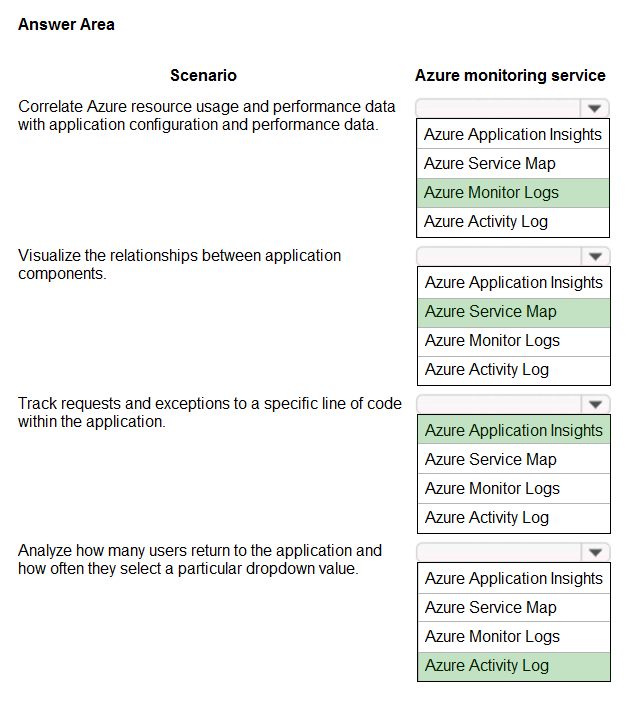
Note: You can select Logs from either the Azure Monitor menu or the Log Analytics workspaces menu.
Reference:
https://docs.microsoft.com/en-us/azure/azure-monitor/log-query/log-query-overview
You have an on-premises Hyper-V cluster. The cluster contains Hyper-V hosts that run Windows Server 2016 Datacenter. The hosts are licensed under a
Microsoft Enterprise Agreement that has Software Assurance.
The Hyper-V cluster contains 30 virtual machines that run Windows Server 2012 R2. Each virtual machine runs a different workload. The workloads have predictable consumption patterns.
You plan to replace the virtual machines with Azure virtual machines that run Windows Server 2016. The virtual machines will be sized according to the consumption pattern of each workload.
You need to recommend a solution to minimize the compute costs of the Azure virtual machines.
Which two recommendations should you include in the solution? Each correct answer presents part of the solution.
NOTE: Each correct selection is worth one point.
Answer:
CD
C: For customers with Software Assurance, Azure Hybrid Benefit for Windows Server allows you to use your on-premises Windows Server licenses and run
Windows virtual machines on Azure at a reduced cost. You can use Azure Hybrid Benefit for Windows Server to deploy new virtual machines with Windows OS.
D: With Azure Reserved VM Instances (RIs) you reserve virtual machines in advance and save up to 80 percent.
Reference:
https://azure.microsoft.com/en-us/pricing/reserved-vm-instances/ https://docs.microsoft.com/en-us/azure/virtual-machines/windows/hybrid-use-benefit-licensing
HOTSPOT -
You have an Azure subscription that contains the SQL servers on Azure shown in the following table.
The subscription contains the storage accounts shown in the following table.
You create the Azure SQL databases shown in the following table.
For each of the following statements, select Yes if the statement is true. Otherwise, select No.
NOTE: Each correct selection is worth one point.
Hot Area: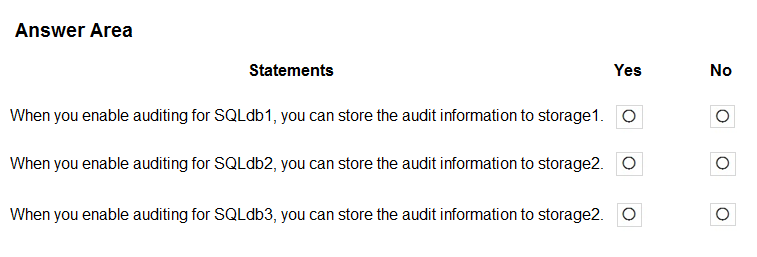
Answer:
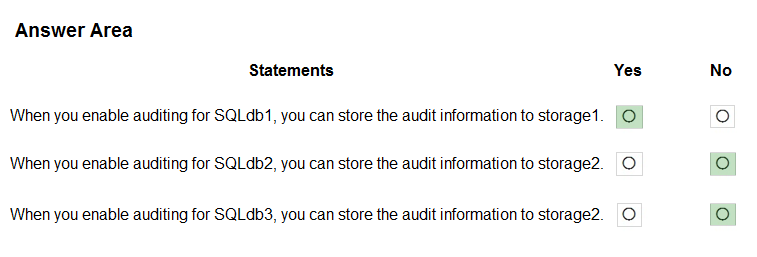
Box 1: Yes -
Be sure that the destination is in the same region as your database and server.
Box 2: No -
Box 3: No -
Reference:
https://docs.microsoft.com/en-us/azure/sql-database/sql-database-auditing
Your company wants to use an Azure Active Directory (Azure AD) hybrid identity solution.
You need to ensure that users can authenticate if the internet connection to the on-premises Active Directory is unavailable. The solution must minimize authentication prompts for the users.
What should you include in the solution?
Answer:
A
With Password hash synchronization + Seamless SSO the authentication is in the cloud.
Incorrect Answers:
Pass-through Authentication and federation rely on on-premises infrastructure.
Reference:
https://docs.microsoft.com/en-us/azure/active-directory/hybrid/choose-ad-authn
HOTSPOT -
You need to design an Azure policy that will implement the following functionality:
✑ For new resources, assign tags and values that match the tags and values of the resource group to which the resources are deployed.
✑ For existing resources, identify whether the tags and values match the tags and values of the resource group that contains the resources.
✑ For any non-compliant resources, trigger auto-generated remediation tasks to create missing tags and values.
The solution must use the principle of least privilege.
What should you include in the design? To answer, select the appropriate options in the answer area.
NOTE: Each correct selection is worth one point.
Hot Area: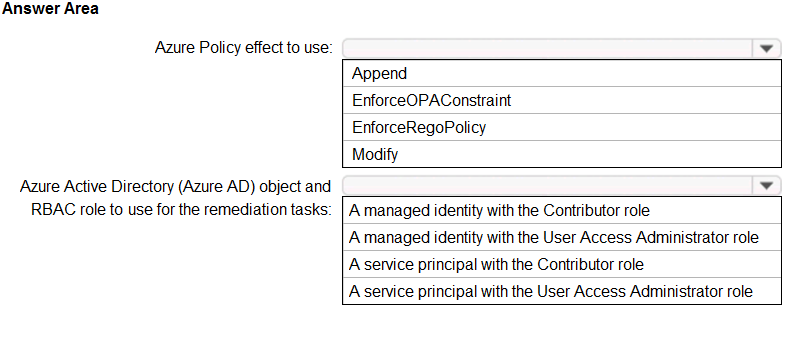
Answer:
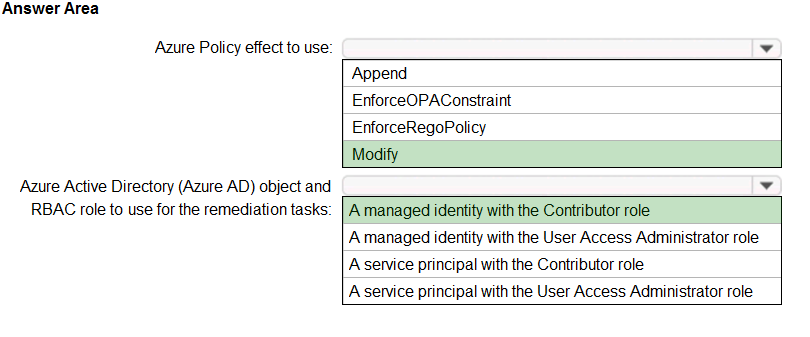
Box 1: Modify -
Modify is used to add, update, or remove properties or tags on a resource during creation or update. A common example is updating tags on resources such as costCenter. Existing non-compliant resources can be remediated with a remediation task. A single Modify rule can have any number of operations.
Incorrect Answers:
✑ The following effects are deprecated: EnforceOPAConstraint, EnforceRegoPolicy
✑ Append is used to add additional fields to the requested resource during creation or update. A common example is specifying allowed IPs for a storage resource.
Box 2: A managed identity with the Contributor role
✑ Managed identity
How remediation security works: When Azure Policy runs the template in the deployIfNotExists policy definition, it does so using a managed identity. Azure
Policy creates a managed identity for each assignment, but must have details about what roles to grant the managed identity.
✑ Contributor role
The Contributor role grants the required access to apply tags to any entity.
Reference:
https://docs.microsoft.com/en-us/azure/governance/policy/concepts/effects https://docs.microsoft.com/en-us/azure/governance/policy/how-to/remediate-resources https://docs.microsoft.com/en-us/azure/azure-resource-manager/management/tag-resources
Note: This question is part of a series of questions that present the same scenario. Each question in the series contains a unique solution that might meet the stated goals. Some question sets might have more than one correct solution, while others might not have a correct solution.
After you answer a question in this section, you will NOT be able to return to it. As a result, these questions will not appear in the review screen.
Your company has an on-premises Active Directory Domain Services (AD DS) domain and an established Azure Active Directory (Azure AD) environment.
Your company would like users to be automatically signed in to cloud apps when they are on their corporate desktops that are connected to the corporate network.
You need to enable single sign-on (SSO) for company users.
Solution: Install and configure an Azure AD Connect server to use password hash synchronization and select the `Enable single sign-on` option.
Does the solution meet the goal?
Answer:
A
Azure Active Directory Seamless Single Sign-On (Azure AD Seamless SSO) automatically signs users in when they are on their corporate devices connected to your corporate network. When enabled, users don't need to type in their passwords to sign in to Azure AD, and usually, even type in their usernames. This feature provides your users easy access to your cloud-based applications without needing any additional on-premises components.
Seamless SSO can be combined with either the Password Hash Synchronization or Pass-through Authentication sign-in methods.
Reference:
https://docs.microsoft.com/en-us/azure/active-directory/hybrid/how-to-connect-sso
Note: This question is part of a series of questions that present the same scenario. Each question in the series contains a unique solution that might meet the stated goals. Some question sets might have more than one correct solution, while others might not have a correct solution.
After you answer a question in this section, you will NOT be able to return to it. As a result, these questions will not appear in the review screen.
Your company has an on-premises Active Directory Domain Services (AD DS) domain and an established Azure Active Directory (Azure AD) environment.
Your company would like users to be automatically signed in to cloud apps when they are on their corporate desktops that are connected to the corporate network.
You need to enable single sign-on (SSO) for company users.
Solution: Install and configure an Azure AD Connect server to use pass-through authentication and select the `Enable single sign-on` option.
Does the solution meet the goal?
Answer:
A
Azure Active Directory Seamless Single Sign-On (Azure AD Seamless SSO) automatically signs users in when they are on their corporate devices connected to your corporate network. When enabled, users don't need to type in their passwords to sign in to Azure AD, and usually, even type in their usernames. This feature provides your users easy access to your cloud-based applications without needing any additional on-premises components.
Seamless SSO can be combined with either the Password Hash Synchronization or Pass-through Authentication sign-in methods.
Reference:
https://docs.microsoft.com/en-us/azure/active-directory/hybrid/how-to-connect-sso
Note: This question is part of a series of questions that present the same scenario. Each question in the series contains a unique solution that might meet the stated goals. Some question sets might have more than one correct solution, while others might not have a correct solution.
After you answer a question in this section, you will NOT be able to return to it. As a result, these questions will not appear in the review screen.
Your company has an on-premises Active Directory Domain Services (AD DS) domain and an established Azure Active Directory (Azure AD) environment.
Your company would like users to be automatically signed in to cloud apps when they are on their corporate desktops that are connected to the corporate network.
You need to enable single sign-on (SSO) for company users.
Solution: Configure an AD DS server in an Azure virtual machine (VM). Configure bidirectional replication.
Does the solution meet the goal?
Answer:
B
Instead install and configure an Azure AD Connect server.
Reference:
https://docs.microsoft.com/en-us/azure/active-directory/hybrid/how-to-connect-sso